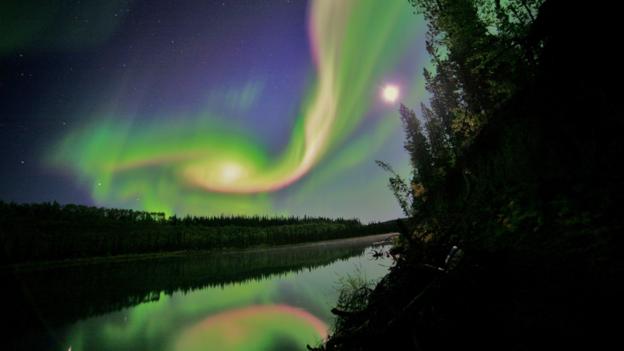 The thermometer on the car is reading -22C. Outside, we are standing
in snow up to my knees. We’re in a region called Inari in Finnish
Lapland, inside the Arctic Circle, the nearest town is some kilometres
to the south of us. You would be forgiven for thinking you were in
Narnia, next to a frozen lake and surrounded by snow-topped pine trees. I
can see more stars then I have ever seen before and some of the
constellations such as Cassiopeia are difficult to spot, the sky is so
free from light pollution. Which is supposedly the ideal place to do
what I am doing; I’m one of a small group of people in search of the
Northern Lights.
The thermometer on the car is reading -22C. Outside, we are standing
in snow up to my knees. We’re in a region called Inari in Finnish
Lapland, inside the Arctic Circle, the nearest town is some kilometres
to the south of us. You would be forgiven for thinking you were in
Narnia, next to a frozen lake and surrounded by snow-topped pine trees. I
can see more stars then I have ever seen before and some of the
constellations such as Cassiopeia are difficult to spot, the sky is so
free from light pollution. Which is supposedly the ideal place to do
what I am doing; I’m one of a small group of people in search of the
Northern Lights.Our group is just one of many tours in this part of the world, eager to see the lights in all their glory. This type of tourism has become big business, several thousands of people choose to chase the lights every winter. Tour companies in regions such as Scandinavia and Alaska battle to find spots they say offer the best chance to see the elusive show. There are also cruises, and even chartered commercial flights, which travel to Arctic airspace to glimpse the phenomenon from above the clouds.
Humans have been fascinated by this unpredictable, eerie light show for centuries. It features in cave paintings in France thought to date back 30,000 years. Aristotle was captivated by the lights, calling them "jumping goats". Galileo described them as the dawn of the north, helping to coin the term aurora borealis. Europeans in the Middle Ages believed that the lights signified famine or war, while Native Americans saw them as gods dancing above the sky.
In this part of the world you don’t just find tour groups or trips with “hunters” chasing breaks in the cloud, more die-hard astronomy fans and photographers hire their own vehicles to chase the lights away from the tourists. “There is this sort of mystical quality to it, it really does pull you in," says astronomer and presenter of the Sky at Night, Pete Lawrence, who has photographed the lights around the world. I see what he means: on the horizon, I see a faint white haze starting to build, appearing initially like the Milky Way on a clear night. The beginning of the aurora slowly changes colour and form, taking over larger parts of the sky as the tour group eagerly set up their cameras.

Energy puzzle
But for such a well-known phenomenon, it’s amazing how little we know about the science beyond the basics. Thanks to work by Norwegian physicist Kristian Birkeland at the turn of the 20th Century, what we know is that auroral activity coincides with sunspots – darker, cooler regions of intense magnetic activity on the Sun’s surface. Birkeland said that currents flowing through the gas of the upper atmosphere caused the light show; in the same way that our modern-day neon lights work. “[Aurora] occur where energised particles coming from the sun interact with the Earth’s magnetic field,” says Lawrence.
What we also know is that aurora are inextricably linked with the activity of the Sun, and that solar activity appears to go through 11-year cycles. When it is at its most active, the so-called solar maximum, there are more sunspots present, and therefore more flares releasing powerful bursts of energy into space, as well as sprays of hot ionised gases, or plasma, that scientists call the solar wind. In theory, this should lead to bigger and brighter displays; however, it’s not quite that clear-cut. At the moment we are heading towards the peak of the current cycle, and Nasa had predicted that the northern lights would be the brightest and most intense for 50 years. But as it’s turned out this is a weak solar maximum, according to Mark Lester, who studies Solar Terrestrial Physics at the University of Leicester. And it’s not as simple to say we see less aurora during a solar minimum, either. There are two large, shifting ovals of auroral activity around the geomagnetic poles – one in the northern hemisphere, the other in the southern hemisphere (where the Southern Lights, or Aurora Australis can be seen). During a solar minimum what you get is aurora at a contracted aurora oval, so not at the place you imagine it to be at,” says Lester.




0 comments:
Post a Comment